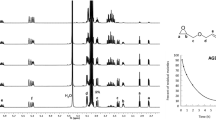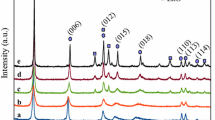Summary
The grafting of minerals by alkenylchlorosilanes leads to organomineral derivatives which are superficially covered by unsaturated organic groups. These groups may be of value when the grafted mineral is used as a reinforcing agent in a polymeric matrix. In this case, the unsaturated grafted groups copolymerize with an organic monomer to build up a composite material. It is therefore of importance to preserve the unsaturated character of the alkenyl-silane during the grafting reactions. It is shown that in certain synthesis conditions, the hydrochloric acid present in the reaction medium adds to the alkenyl-groups. For instance, in the grafting of methylvinyl-dichlorosilane, this reaction is of minor importance, whereas in the case of allyldimethylchlorosilane, no allyl groups are grafted as such on the mineral surface.
Zusammenfassung
Die Pfropfung von silicatischen Mineralen mit Alkenylchlorosilanen führt zu organischen Derivaten, deren Oberfläche mit ungesättigten organischen Gruppen bedeckt ist. Diese Gruppen können Vorteile bieten, wenn die so behandelten Minerale als Fül-stoffe oder Verstärker in einer Polymermatrix eingesetzt werden. Die ungesättigten Gruppen können miteinem organischen Monomer kopolymerisieren und ein echtes Verbundmaterial bilden. Die Pfropfung muß allerdings so geführt werden, daß der ungesättigte Charakter der Alkenylsilane erhalten bleibt. In der Arbeit werden experimentelle Bedingungen dafür berichtet.
Similar content being viewed by others
References
Edwards, H., J. Appl. Chem.20, 76 (1970).
Zapata, L. E., J. Castelein, J. P. Mercier, J. J. Fripiat, Bull. Soc. Chim.,54 (1972).
Ruiz-Hitzky, E., J. J. Fripiat, Bull. Soc. Chim., 1341 (1976).
Zapata, L. E., A. Van Meerbeek, J. J. Fripiat, M. della Faille, M. Van Russell, J. P. Mercier, J. Polymer Sci., Symposium No. 42, 257 (1973).
Ruiz-Hitzky, E., J. J. Fripiat, Clays Clay Min.24, 25 (1976).
Bellamy, L. J., The Infrared Spectra of Complex Molecules, 2nd. edit., p. 13, 34 (London 1966).
Ruiz-Hitzky, E., A. Van Meerbeek, Colloid & Polymer Sci.256, 135 (1978).
Barrios-Neira, J., L. Rodrique, E. Ruiz-Hitzky, J. Microscopie20, 295 (1974).
Eaborn, C., Organosilicon Compounds, 1st. edit., Butterworths Scientific Publications, p. 140, 289 (London 1960).
Sommer, L. H., D. L. Bailey, F. C. Whitmore, J. Am. Chem. Soc.70, 2869 (1948).
Bailey, D. L., A. N. Pines, Ind. Engin. Chem.46, 2363 (1954).
Chang, J. J., A. Pines, J. J. Fripiat, H. A. Resing, Surface Sci.47, 661 (1975).
Author information
Authors and Affiliations
Additional information
With 2 figures
Part 1: “Nature and role of the hydrolysis products of the methylvinyldichlorosilane in the grafting of silicates in hydrochloric acid and isopropanol”This journal 256, 135 (1978).
Rights and permissions
About this article
Cite this article
Van Meerbeek, A., Ruiz-Hitzky, E. Mechanism of the grafting of organosilanes on mineral surfaces. Colloid & Polymer Sci 257, 178–181 (1979). https://doi.org/10.1007/BF01638145
Received:
Issue Date:
DOI: https://doi.org/10.1007/BF01638145




